Salmon fishery statistics: 2014 season
Salmon catch statistics for Scotland for the 2014 season.
Catch and Effort Reported by Scottish Salmon Fisheries in 2014
The rod and line fishery
A total of 8,036 wild salmon and grilse was reported caught and retained in the rod and line fishery. A further 37,139 wild salmon and grilse were reported caught and released. The combined retained and released rod catch is 45,175, which is 53% of the previous 5-year average and is the second lowest reported catch since records began in 1952. We have no time series of fishing effort information associated with the rod and line fishery.
Annual rod catch showed a general increase over the period 1952 to 2010. The reported catch has dropped in each subsequent year however and in 2014 was the second lowest on record ( Figure 1).
Trends in total rod catch vary among individual stock components ( Figure 2). Spring salmon catch (for the purposes of this report defined as multi sea-winter fish taken before 1 May) shows a general decline since records began. Although there is some indication that spring salmon catch has stabilised in recent years, it remains at a historically low level. Overall catch of salmon and grilse in later months showed a general increase up to 2010, after which it has fallen sharply.
FIGURE 1 ROD AND LINE FISHERY.
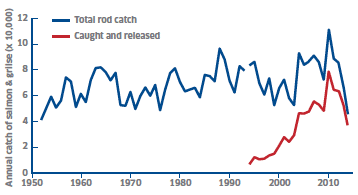
FIGURE 2 TRENDS IN STOCK COMPONENTS, ROD AND LINE FISHERY.
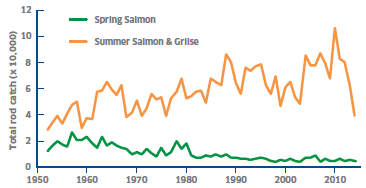
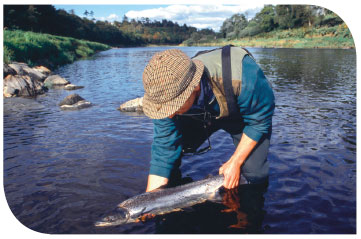
PHOTO BY DAVID HAY, © CROWN COPYRIGHT
Catch and release
The proportion of the rod catch accounted for by catch and release has generally increased since 1994, when such information was first recorded. In 2014, 82% of the annual rod catch was released compared to less than 8% in 1994. Similarly, less than 1% of rod caught spring salmon were released in 1994 while 93% were released in 2014 ( Figure 3). A proportion of fish released from the rod fishery may be re-caught and hence inflate the catch statistics by appearing in the reported data more than once.
FIGURE 3 CATCH AND RELEASE, ROD AND LINE FISHERY.
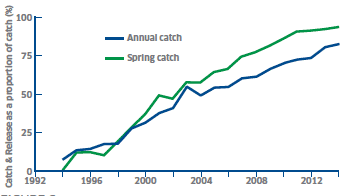
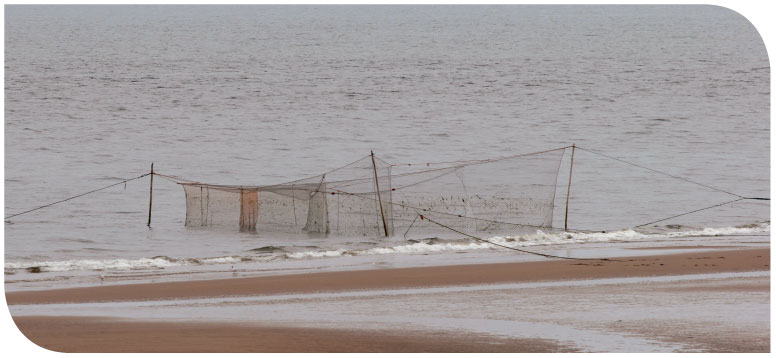
PHOTO BY DAVID HAY, © CROWN COPYRIGHT
The net fisheries
A total of 13,343 wild salmon and grilse was reported caught and retained in the fixed engine fishery, and the national index of netting effort was 203.5 trap months. A total of 4,435 wild salmon and grilse was reported caught and retained in the net & coble fishery from a reported effort of 55 crew months.
Reported catch and effort have declined in both net fisheries over much of the period covered by our records and remain at historically low levels (Figures 4 & 5). In 2014, fishing effort in the fixed engine and net & coble fisheries was the fifth lowest and lowest, respectively, since records began in 1952. Reported catch in each fishery was 5% and 2% of the maximum reported in the respective time series.
FIGURE 4 FIXED ENGINE FISHERY.
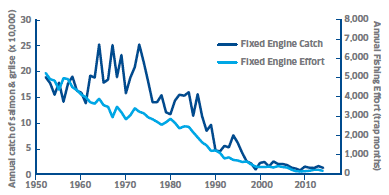
The catch by fishing method
In 2014, 72% of the total annual reported catch was accounted for by the rod fisheries. Fixed engine and net & coble fisheries took 21% and 7% respectively. Restricting the analysis to the retained catch, the rods accounted for 31% of the catch compared to 52% and 17% for the fixed engine and net & coble fisheries.
Similarly for spring salmon in 2014, rod fisheries accounted for 98% of the overall reported catch while fixed engine fisheries comprised the remaining 2% and net and coble fisheries accounted for less than 1%. Restricting the analysis to the retained catch, the rods accounted for 75% with the fixed engine and net and coble fisheries comprising 21% and 4% respectively.
FIGURE 5 NET AND COBLE FISHERY.
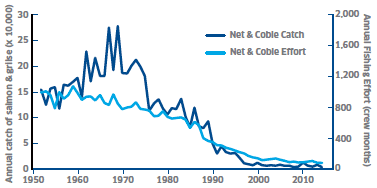
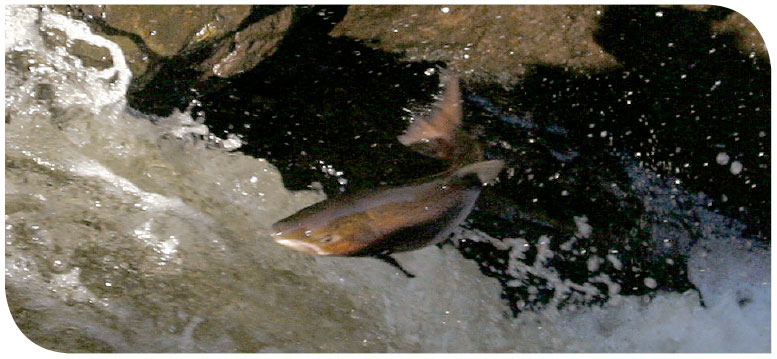
PHOTO BY DAVID HAY, © CROWN COPYRIGHT
Farmed salmon and grilse
A total of 35 fish of farmed origin was reported caught by all methods in 2014. Salmon and grilse of farmed origin represented 0.1% of the total number of salmon and grilse caught. The distribution of farmed origin fish was highly uneven, the North West region accounting for 77% of reports. Scottish regions are shown in MS Topic Sheet 67 ( http://www.gov.scot/Topics/marine/science/Publications/TopicSheets/tslist).
Contact
If you have a specific request for Scottish salmon and sea trout fishery information, please contact us directly at ms.catchform@scotland.gsi.gov.uk
Downloads
Topic sheet no. 67 explains how we collect the catch statistics.
Topic sheet no. 69 summarises the sea trout fishery statistics for the 2014 fishing season.
Both topic sheets are available for download at http://www.gov.scot/Topics/marine/Publications/TopicSheets/tslist
Summary data for the 2014 fishing season are available for download at http://www.gov.scot/Topics/marine/science/Publications/stats/SalmonSeaTroutCatches
The data provided for download are the best available at the time of publication. Our records are amended when further information is provided and the most accurate historical data may be obtained directly from us.
Freshwater Fisheries Laboratory
blogs.scotland.gov.uk/coastal-monitoring/
www.flickr.com/marinescotland
www.youtube.com/marinescotlandvideo
@GreenerScotland
Contact
There is a problem
Thanks for your feedback